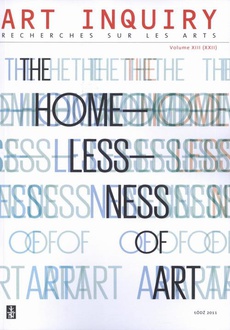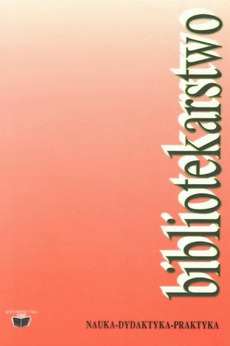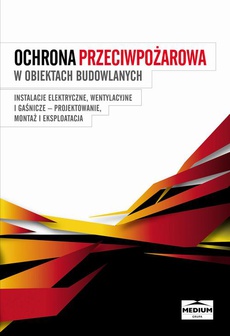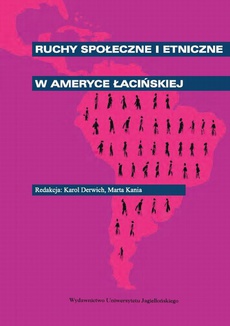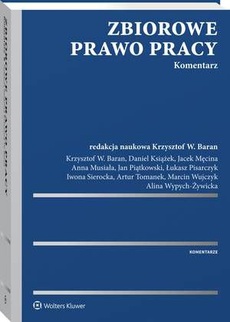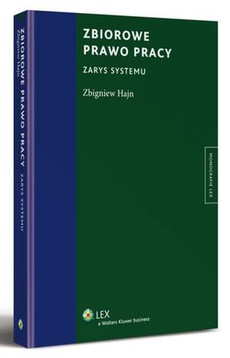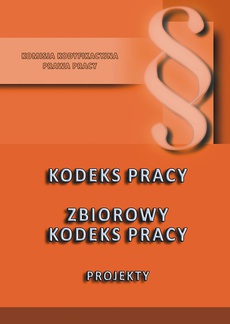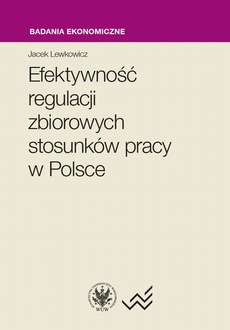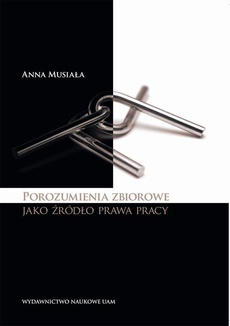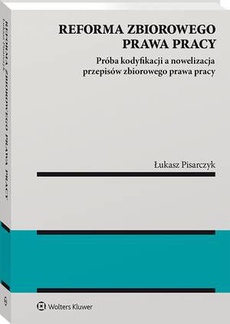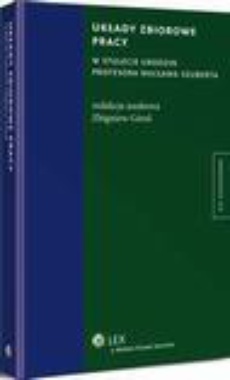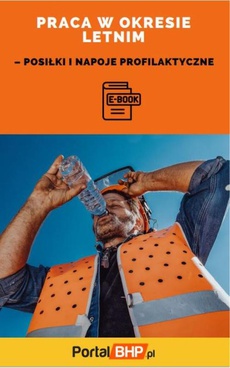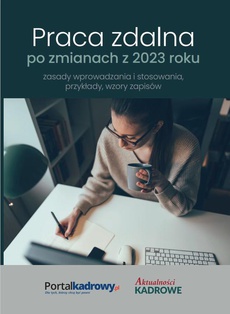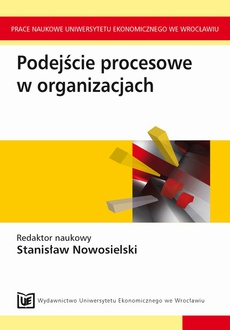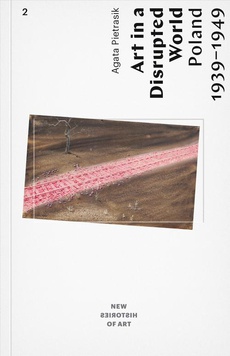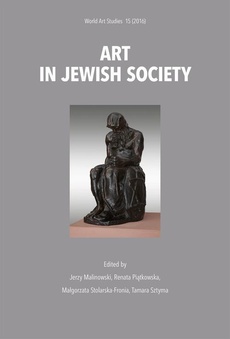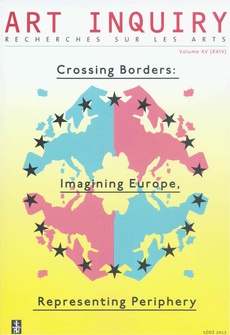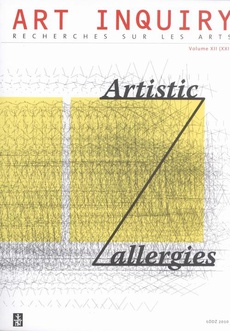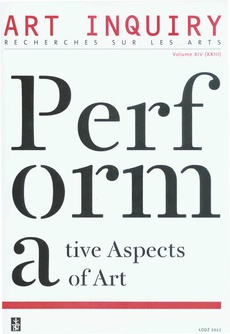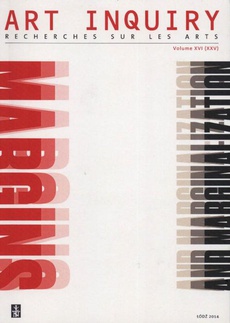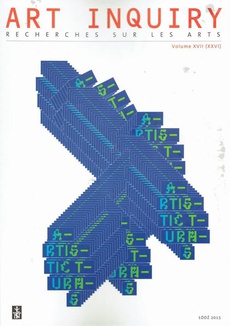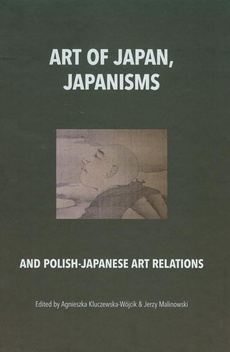INNE EBOOKI AUTORA
Art Inquiry. Recherches sur les arts. Volume XIII (XXII)
Praca zbiorowa
Redakcja:
Grzegorz Sztabiński, Andrzej Bartczak, Ryszard Kluszczyński, Krzysztof Stefański, Paulina Sztabińska
Wydawca:
Format:
ibuk
THE HOMELESSNESS OF ART
References to „being settled” somewhere and being „homeless” have reappeared
in various disciplines of the humanities for a long time. Those concepts were used
in different contexts and in different senses. In 20th century philosophy, much
attention was paid to the Heideggerian concept of man as “the neighbour of
Being”, i.e. his dwelling “in the nearness of Being”. This image led to attempts at
discovering what is unique to the human condition. Lukacs offered a critique of
„transcendental homelessness”, which he saw as characteristic of contemporary
culture. Other philosophers pointed out that the fast-changing reality and the
engagement in utopian projects characteristic for the condition of the modern
man, are conducive to our loss of the sense of settlement.
The second half of the 20th century introduced the discourse of unsettlement,
non-belonging. Adorno negated the possibility of feeling at home in the world
after Auschwitz. Other authors offered the concept of “the uncanny” (das Unheimliche),
or being faced with strange and incomprehensible forces in one’s own
home, only illusorily familiar. It has been also pointed out that the sense of
settlement and the associated feeling of safety may turn out to be limiting. Freedom
must mean the loss of the sense of safety, familiarity, commitment. Encountering
what is different, marginal, often suffering or victimized (e.g. in
feminist or postcolonial discourses) also sensitizes us to the importance of opening
ourselves to new experience, which leads to the de-stabilization of our own
monolithic home.
The subject area outlined here may be variously related to art. On the one
hand, art may be considered as an important voice in the discussion on our sense
of belonging or uprootedness, on the other the question of whether it should be
rooted in tradition, or leave this “home” to gain new experiences is also pertinent.
The volume of Art Inquiry to which we seek your contributions will be devoted
to this set of issues. Your prospective papers should concern some theoretical
aspects of the concepts mentioned above in relation to art, artistic activity,
reception of art works, or offer a case study of some artistic endeavour in which
those concepts have taken a concrete shape.
BEZDOMNOŚĆ SZTUKI
Sformułowania nawiązujące do pojęć „zadomowienia” i „bezdomności” od kilkudziesięciu
lat pojawiają się w różnych obszarach humanistyki. Występują one
w wielu kontekstach i nadawany jest im różny sens. W filozofii XX wieku podstawowe
znaczenie ma Heideggerowski problem człowieka jako „sąsiada bycia”,
czyli zamieszkiwania przez niego w „bliskości wobec bycia”. Ta wysoka ocena
bliskości prowadziła do sugestii odzyskania tego, co własne i właściwe dla ludzkiego
sposobu istnienia. Lukacs poddawał krytyce „transcendentalną bezdomność”,
którą uważał za charakterystyczną dla współczesnej kultury. Inni filozofowie
zwracali uwagę na to, że zachodzenie szybkich zmian, a także formułowanie
utopijnych projektów charakterystyczne dla nowoczesnej kondycji człowieka,
sprzyja utracie uczucia zadomowienia.
W drugiej połowie XX wieku, rozwijał się też dyskurs związany z kryzysem
zamieszkiwania. Adorno negował możliwość uczucia zadomowienia w świecie
po Auschwitz. Inni autorzy brali pod uwagę „nieswojość” (das Unheimliche),
czyli występowanie obcych i niezrozumiałych sił we własnym domu, pozornie
tylko oswojonym. Podkreślano też, że zadomowienie i związane z nim poczucie
bezpieczeństwa może okazać się ograniczające. Za wolność płaci się przecież na
ogół utratą poczucia bezpieczeństwa, zanikiem stanu bliskości, zażyłości. Także
wzięcie pod uwagę tego, co inne, marginalne, często cierpiące lub poszkodowane
(np. w dyskursach feministycznym i postkolonialnym), uwrażliwia na rolę otwarcia,
które prowadzi do destabilizacji monolitycznie pojmowanego własnego domu.
Zarysowany tu krąg problematyki w różny sposób odnosi się do sztuki. Z jednej
strony może ona być rozważana jako ważny głos w sporach dotyczących zadomowienia
i bezdomności, z drugiej zaś w odniesieniu do niej samej można
stawiać pytania o potrzebę zakorzenienia w tradycji, albo poszukiwania przez nią
nowych miejsc. Wzięciu pod uwagę tego bogatego zestawu zagadnień poświęcony
będzie tegoroczny tom „Art Inquiry”. Nadsyłane artykuły dotyczyć mogą
albo teoretycznych aspektów zadomowienia i bezdomności w sztuce, działalności
artysty, odbiorze dzieł, albo prezentować konkretne przykłady z zakresu
różnych dziedzin twórczości artystycznej, w których tytułowe zjawisko przybierało
konkretną postać.
| Rok wydania | 2011 |
|---|---|
| Liczba stron | 301 |
| Kategoria | Publikacje darmowe |
| Wydawca | Łódzkie Towarzystwo Naukowe |
| Numer wydania | 1 |
| Język publikacji | angielski |
| Informacja o sprzedawcy | ePWN sp. z o.o. |
POLECAMY
Ciekawe propozycje
Spis treści
| Introduction ...............................7 | |
| TERESA PĘKALA – The art of great masters on a mountain pass .............................9 | |
| ANDRZEJ MARZEC – The aesthetics of hospitality: the deconstructions of the athome ......19 | |
| AGNIESZKA REJNIAK-MAJEWSKA – The construction of subjectivity in Theodor W. Adorno’s aesthetic theory: criticality, reflection, mimesis ...35 | |
| ROMAN KUBICKI – On the twilight of artworks in the world of art ............................53 | |
| RAFAŁ SOLEWSKI – Identity in dialogue or homeless despair? Critical sensitivity in Polish art at the turn of the 21st century ................63 | |
| ELEONORA JEDLIŃSKA – Homelessness of art work / Homelessness of Memory: Moshe Kupferman’s “The Rift in Time” ...................75 | |
| IRMINA GADOWSKA – Homelessness as the determiner of the artistic work of the Jewish diaspora in Central and Eastern Europe before 1939 .. 95 | |
| RYSZARD W. KLUSZCZYŃSKI – Nomadic images. Transmediality and hybridity in contemporary media art .................119 | |
| SŁAWOMIR MARZEC – Artworld versus Arthome .... 135 | |
| GRZEGORZ DZIAMSKI – The place of art. Where? In a supermarket .......................147 | |
| EWA KUBIAK, JOANNA PIETRASZCZYK-SĘKOWSKA – The “homelessness” of the Catholic Church and the sacral buildings in Andean Peru: Juli, Rondocán, | |
| Aranhuay and Chaca ............ 159 | |
| ANETA PAWŁOWSKA – Transitional Art in South Africa .....................................183 | |
| ALEKSANDRA SUMOROK – The socialist city – a homeless city? A contribution to research on model implementations ....................205 | |
| PAULINA SZTABIŃSKA – Geometric art and the idea of belonging ...........................231 | |
| WIOLETTA KAZIMIERSKA-JERZYK – Settlement as a performative aspect of art | |
| and aesthetics (Zbiegniew Warpechowski’s creative attitude) ..........................251 | |
| AGNIESZKA GRALIŃSKA-TOBOREK – Greece – the irretrievably lost home of art ..269 | |
| VICTORIA VESNA, JAMES GIMZEWSKI – Blue Morph: Reflections on Performance | |
| of Self Organized Criticality 2011 ... 287 | |
| GRZEGORZ SZTABIŃSKI – Feeling at home in art ................... 295 | |
| Notes on Contributors ...... 301 | |

